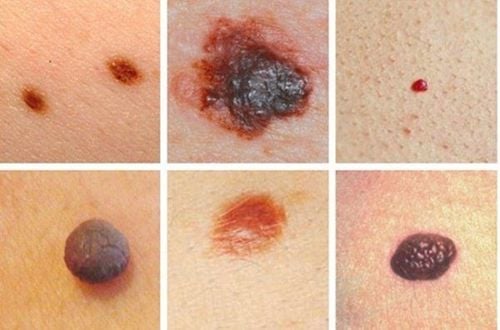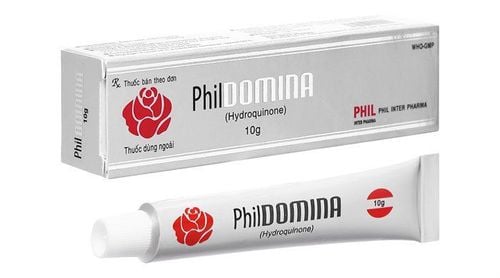This is an automatically translated article.
Different types of moles have different characteristics and are mostly harmless. They are not contagious and do not cause pain, itching, or bleeding. A mole can last up to 50 years. However, see a dermatologist if you suspect that a mole is abnormal.
1. What is a mole?
Skin is the largest organ on our body. Skin moles (“nevus” or “nevi” is the medical term) are moles that grow on your skin that range in color from your natural skin tone to brown or black. Moles can appear anywhere on your skin or mucous membranes, singly or in groups.
Most skin moles appear during childhood and during the first 20 years of life. In adulthood, it is normal for a person to have between 10 and 40 moles.
The life cycle of an average mole is about 50 years. As the years go by, moles usually change slowly, becoming raised and lighter in color. Often, hairs can develop on moles. Some moles will remain unchanged and some will slowly disappear over time.
2. Why are there moles?
Moles happen when the cells on your skin grow into a cluster instead of spreading all over the skin. Most moles are made of cells called melanocytes, which produce the pigment that gives your skin its natural color.
The risk factor for skin moles is excessive sunlight. Moles can darken after sun exposure, during pregnancy, and during puberty. During pregnancy, moles often change uniformly due to the influence of hormones. For example, they may darken or become larger. However, if the mole changes irregularly or unevenly, see a dermatologist for an accurate evaluation.
3. Types of moles
Moles are classified into several types as follows:
Ordinary mole: This is a normal mole, a small mole that grows on your skin that is pink, tan or brown and has a clear edge. Congenital Mole: This is one of the types of moles discovered on the skin when you were born. Congenital moles occur in about 1 in 100 people. These moles may be more likely to develop into melanoma than those that appear after birth. If a mole on your skin is more than 8 mm in diameter, it has a higher risk of becoming cancerous. Atypical moles (Dysplastic Nevi): These moles are larger than a pencil eraser and irregularly shaped. Dysplastic moles tend to be uneven in color with dark brown centers and lighter, uneven edges. These moles have a genetic tendency, and people who have them can have more than 100 moles. If you have dysplastic mole, you are more likely to develop melanoma. Any changes to the mole should be checked by a dermatologist for skin cancer.

Các loại nốt ruồi thường có đặc điểm khác nhau
4. Some characteristics of moles
Types of moles often have different characteristics, specifically:
Moles are very common: Most people have about 10 to 40 moles on their body. Most moles grow on parts of your body that receive sunlight (ultraviolet radiation). You may find that you have more moles the longer you stay in the sun. Moles are not contagious. If the mole on the skin is tender or painful, you need to see a dermatologist. If a mole on your skin itches, you need to see a dermatologist. You need to see a dermatologist if your mole is bleeding. "Pigmented lesions" is a general term that includes normal moles, sun freckle, or age spots (grainy). Although most pigmented lesions will not become cancerous, if there are multiple or unusual lesions, you should see your dermatologist regularly for a comprehensive skin exam. Regular monitoring allows the dermatologist to identify changes in lesions that look "suspicious". A change that could prompt a skin biopsy (removal of a sample of a mole for detailed examination under a microscope), which can help determine if the lesion is melanoma or another type of skin cancer . Always use caution if you are over 30 years old and discover a new mole. It may be harmless, but you should still see a dermatologist for a careful examination. The most significant complication is that some moles can turn into melanoma.
5. What should be noted when checking moles on the skin?
Most skin moles are benign (not cancerous). Moles of medical concern are moles that look different from other existing moles on your body or moles that appear on your skin after the age of 30.
If you notice changes About the color of any mole, thickness, size, or shape, you should see a dermatologist. You should also check your moles for bleeding, oozing, itching, crusting, or becoming tender or painful.
Look at your skin in a mirror or ask someone for help. Pay special attention to areas of the skin that are often exposed to the sun such as the face, hands, feet (especially in women), arms, chest and back (especially in men).
Important signs of moles could be cancer. If a mole has any of the signs listed below, see a dermatologist right away:
Asymmetry: If half of your moles don't fit the other half. Boundary: If the border or edges of your mole are torn, blurred, or uneven. Color: If the color of the mole is not the same, it is transparent or it has many shades such as tan, brown, black, blue, white or red. Diameter: If your mole's diameter is larger than a pencil eraser. Elevation/growth: If your mole becomes larger, higher than the surface of the skin, or it changes over a short period of time. The most common site of melanoma in men is the back and in women is the lower leg. Melanoma is the most common cancer in women between the ages of 25 and 29.

Các loại nốt ruồi cần được kiểm tra cẩn thận khi xuất hiện bất thường
6. Should moles be removed on the skin?
Normal (benign) skin moles do not need to be removed. If you choose to have it removed, you will likely leave a scar.
If your dermatologist determines that a mole is a concern, he or she will perform a skin biopsy, in which a small sample of the mole is taken for examination under a microscope. Diagnosis can usually be made in less than a week. If the mole is found to be cancerous, it should be completely removed.
If you are concerned that your mole is changing or if you see any worrying signs, please contact your dermatologist to have your mole checked.
Don't try to remove moles yourself, even if you're using some kind of over-the-counter product that burns, freezes, or uses a laser to remove skin growths such as moles or moles. and freckles.
Not only can you get an infection, but you can also accidentally remove a melanoma (skin cancer). Skin cancer can spread to other organs if not detected early and one way to detect it is to identify abnormal moles.
7. Can new moles be prevented?
Moles are natural growths on the skin that cannot be prevented. However, you can proactively prevent skin cancer (or detect it early) by:
Limiting the amount of sunlight you get. Apply sunscreen every day. Check your moles at least once a month, looking for abnormalities. Proactive skin cancer prevention is important for your health. This is especially true if:
You have fair skin. You have many moles on your body. Your family members have multiple moles, atypical moles, or a history of skin cancer. In addition to limiting sun exposure and using sunscreen every day, getting your moles checked will increase your chances of early detection and treatment of melanoma and other types of skin cancer. .
Dermatologists recommend monthly dermatology exams. Most moles are benign, not cancerous. If you notice changes in the color or shape of your mole, see a dermatologist to have your mole evaluated. You should also check the moles if they bleed, ooze, itch, scab, become tender, or painful.

Hãy chủ động kiểm tra các loại nốt ruồi khi bạn thấy bất thường
8. How should you self-examine your moles?
Perform a monthly skin self-exam: It's best to check your skin after bathing, while it's still wet. Use a full-body mirror (if you have one) as well as a hand-held mirror, for a closer look. Ask a family member, if available, for help with more difficult positions, such as your back. Try to check yourself the same way every month to avoid missing any areas. Start from your head and work your way up. Look at all areas of your body (including the front, back, and sides of each, and your fingernails and toenails). Also, be sure to check the "hidden" areas: Between the fingers and toes, the groin, the soles of the feet, and the back of the knees. Don't forget to double-check your scalp and neck for moles. Keep track of all the moles on your body and what they look like. Take a picture with a ruler in it and date it. That way, you'll notice if the moles have changed. If they change in any way (in color, shape, size, contour, etc.) or if you develop a sore that won't heal, you should see a dermatologist. Also ask your dermatologist to examine any new moles that you think are suspicious. You should always be suspicious of a new mole developing after the age of 30. Many moles that appear after the age of 30 are harmless age-related moles rather than malignant moles. However, if you notice a new growth, you should see a dermatologist. Your doctor will examine the growth and perform a skin biopsy, if indicated.
Moles can develop on any surface of the skin or mucous membranes (mouth, eyes, genitals). If you have ever had melanoma or have a family history of melanoma, in addition to regular visits by a dermatologist, you should have an annual checkup with your dentist, eye doctor, and doctor. gynecology to find moles in these special locations.
Please dial HOTLINE for more information or register for an appointment HERE. Download MyVinmec app to make appointments faster and to manage your bookings easily.
References: my.clevelandclinic.org













